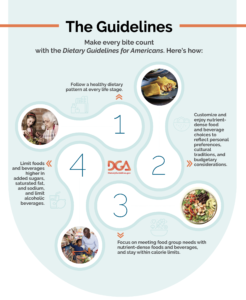2020-2025 Dietary Guidelines for Americans
go.ncsu.edu/readext?766532
en Español / em Português
El inglés es el idioma de control de esta página. En la medida en que haya algún conflicto entre la traducción al inglés y la traducción, el inglés prevalece.
Al hacer clic en el enlace de traducción se activa un servicio de traducción gratuito para convertir la página al español. Al igual que con cualquier traducción por Internet, la conversión no es sensible al contexto y puede que no traduzca el texto en su significado original. NC State Extension no garantiza la exactitud del texto traducido. Por favor, tenga en cuenta que algunas aplicaciones y/o servicios pueden no funcionar como se espera cuando se traducen.
Português
Inglês é o idioma de controle desta página. Na medida que haja algum conflito entre o texto original em Inglês e a tradução, o Inglês prevalece.
Ao clicar no link de tradução, um serviço gratuito de tradução será ativado para converter a página para o Português. Como em qualquer tradução pela internet, a conversão não é sensivel ao contexto e pode não ocorrer a tradução para o significado orginal. O serviço de Extensão da Carolina do Norte (NC State Extension) não garante a exatidão do texto traduzido. Por favor, observe que algumas funções ou serviços podem não funcionar como esperado após a tradução.
English
English is the controlling language of this page. To the extent there is any conflict between the English text and the translation, English controls.
Clicking on the translation link activates a free translation service to convert the page to Spanish. As with any Internet translation, the conversion is not context-sensitive and may not translate the text to its original meaning. NC State Extension does not guarantee the accuracy of the translated text. Please note that some applications and/or services may not function as expected when translated.
Collapse ▲Written by Dr. Lindsey Haynes-Maslow and Catherine Hill
“Make every bite count” is the theme of the newly released 2020-2025 Dietary Guidelines for Americans. Every 5 years a Dietary Guidelines Advisory Committee is selected to evaluate evidence-based nutrition studies and write a scientific report summarizing recommendations to the federal government. The U.S. Departments of Agriculture (USDA) and Health and Human Services (HHS) use this report, along with comments from the public and other federal agencies, to inform the new edition of the Dietary Guidelines for Americans.
The ninth edition’s goal is to promote health and prevent disease, as more than half of American adults have one or more diet-related chronic diseases, such as obesity, Type 2 diabetes, heart disease, and stroke. These new Guidelines also provide a framework for federal nutrition programs, including SNAP and SNAP-Education, designed for the public. We all have a role to play in supporting all families and individuals in making healthy choices. This includes taking into account convenience and affordability of healthy food and beverage options. Four overarching messages create the backbone of the 2020-2025 Dietary Guidelines for Americans:
1. Promote a healthy dietary pattern at every stage of life. For the first time, the Guidelines include recommendations for every stage of life – infancy, toddlerhood, childhood, adolescence, adulthood, pregnancy, lactation, and older adulthood.
2. Customize and enjoy nutrient-dense food and beverage choices to reflect personal preferences, cultural traditions, and budgetary considerations. Another key addition to the new Guidelines is that just about everyone, and not just healthy individuals, can benefit from shifting towards a more nutrient-dense eating pattern.
3. Focus on meeting food group needs with nutrient-dense foods and beverages, and stay within calorie limits. A continued focus within the Guidelines is to promote nutrient-dense foods and beverages as they provide vitamins and minerals and have little added sugars, saturated fat, and sodium.
4. Limit foods and beverages higher in added sugars, saturated fat, and sodium, and limit alcoholic beverages. A healthy dietary pattern within calorie limits does not leave much room for extra added sugar, saturated fat, sodium, or alcoholic beverages.
Stay tuned as we dive deeper into these recommendations in the coming months at Steps to Health!.

Dietary Guidelines 2020-2025


